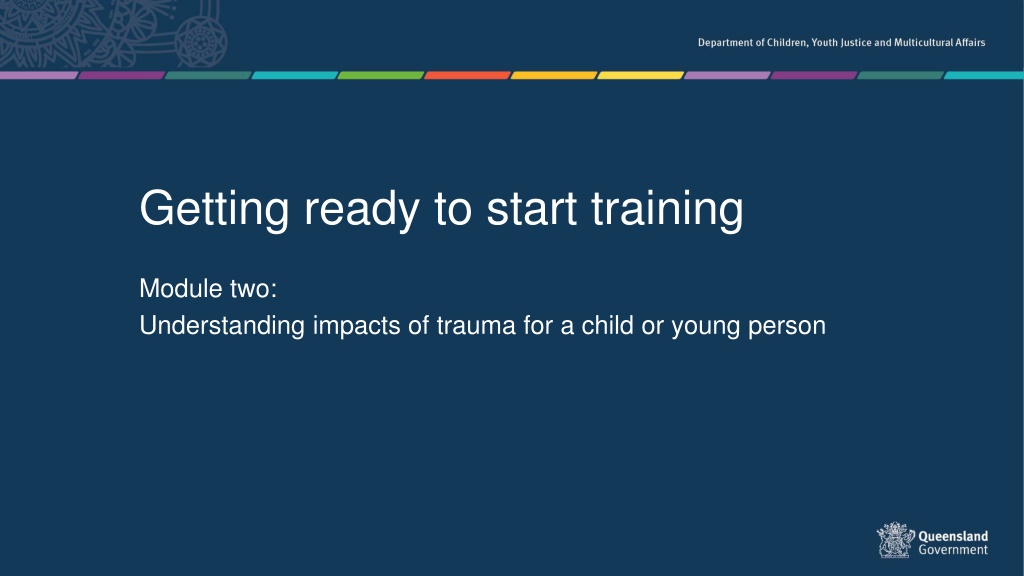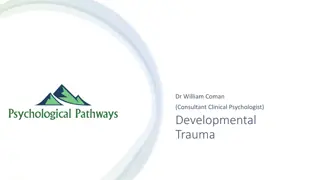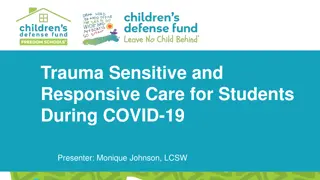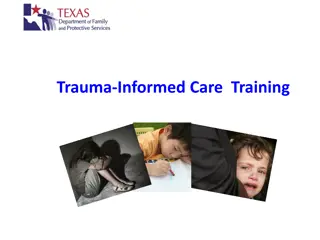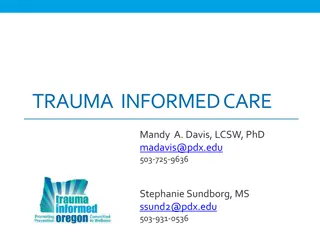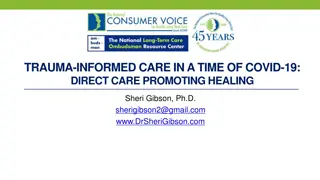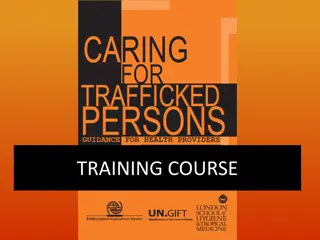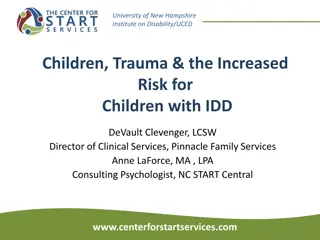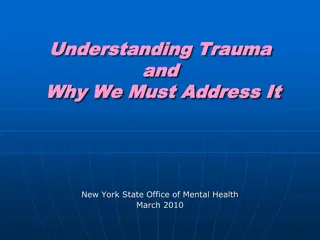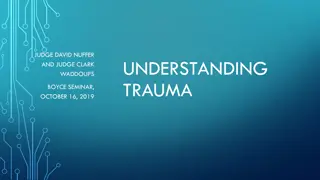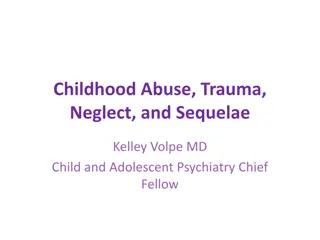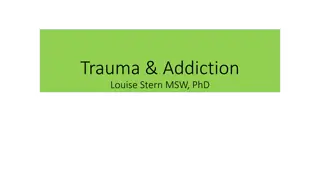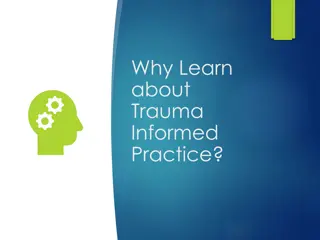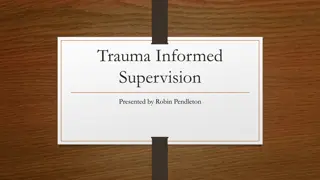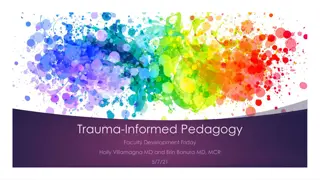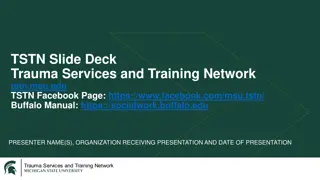Understanding Trauma Impacts on Children in Care
Children in care may exhibit unexpected behaviors due to exposure to abuse, neglect, poor attachments, and experiences of grief and loss. Module two of the training program focuses on understanding the impacts of trauma on children and young people, covering topics such as developmental stages, experiences of abuse, attachment, loss, and positive behavior supports. By the end of the module, participants will gain insight into how trauma affects childhood development and ways to manage high-risk behaviors effectively.
Download Presentation

Please find below an Image/Link to download the presentation.
The content on the website is provided AS IS for your information and personal use only. It may not be sold, licensed, or shared on other websites without obtaining consent from the author. Download presentation by click this link. If you encounter any issues during the download, it is possible that the publisher has removed the file from their server.
E N D
Presentation Transcript
Getting ready to start training Module two: Understanding impacts of trauma for a child or young person
Getting ready to start Training modules Each participant will be assessed throughout the four modules on the following learning objectives: Module one context of foster care - completed An understanding of the process of how children and young people come into care and the impact of this process, and why children and young people require a care arrangement. Module two understanding impacts of trauma for a child or young person An understanding of trauma and related behaviours for a child or young person who is in care arrangement. Module three early days in a care arrangement Developing knowledge and skills required to meet the physical, emotional and social needs of children and young people in care and an understanding of the importance of participation by children and young people and their families in decision making. Module four Quality care & working together Have an understanding of the importance of partnerships between children, their families, foster and kinship carers and workers, (both in the government and non-government sectors), and their roles and responsibilities when working together as a team.
Module two Understanding impacts of trauma for a child or young person Learning outcomes module two At the end of this module you will be able to: Understand the basic developmental stages of childhood and adolescence Understand the experience of abuse and harm and how these impact on children Understand what attachment means for a child, and how separation impacts on attachment Identify the types of losses that may be experienced by children who come into care and by birth family members Understand positive behaviour supports and options for managing high risk behaviours
Understanding impacts of trauma for a child or young person 1. Understanding trauma for children and young people 30 mins 2. How trauma may impact stages of childhood development 40 mins Attachment Stages of Grief and Loss 3. The experience of abuse 40 mins Sexualised behaviours Self Harm Responding to disclosures 4. Responding to challenging behaviours 30 mins Positive behaviour supports Managing high risk behaviours
Trauma Children in care may not behave or respond how we might expect due to: Exposure to abuse and neglect Poor attachments to primary carers or significant others Experiences of grief and loss
Trauma The impact of these experiences are sometimes: Difficulties with emotions angry, anxious, incorrect emotional response for situation, shame Difficulties with social situations fear, distrust, avoidance, isolation, test people Difficulties with relationships problematic relationships, avoids intimacy, fear rejection, limited positive attachments Developmental delays different stage than peers Challenging behaviours self harm, hostile, aggressive
Trauma What can carers do? Support and empathise with the child Listen carefully to the child Encourage the child to participate in decision making Be consistent and committed to the child Understand attachment, grief and loss Help maintain important relationships to the child Positive role model Teach Read, train, learn and ask Stay calm and seek support
How trauma may impact stages of childhood development
Developmental stages What milestones do you know? How can you help a child meet developmental levels?
Attachment A bond cooing, smiling. Attachment is more than a bond it is a relationship - the development of nurturing, soothing and trusting relationship. Attachment is where the child feels and finds safety and security in the context of the relationship. Children and young people can and do form attachment relationships with other people throughout their lives. The best outcomes for children occur when foster carers really commit to developing an attachment relationship with the child.
Attachment what can carers do? Preserve existing attachments with family, friends, school and cultural and community members Stay committed to the child and your relationship be there through the tough times and beyond the age of 18 years Be consistent, reliable and predictable model and teach Engage in healthy relationships promote friendships, join a sports team Try to understand why the child is behaving this way work with their issues as well as their behaviour Respond according to the child s emotional level Don t take their behaviour personally Celebrate achievements, no matter how small
Stages of Grief and Loss Emotion Reaction Shock Feel numb Denial Pretend its not happening, avoid thinking about it by keeping really busy Anger Why me? Anger or making people around us angry Deep sadness Cry over all sorts of things, feel really low all the time Acceptance Accept what is happening and ability to move on Children do not automatically move through each stage. Children may move in or out or even between stages depending on the situation or events they are experiencing at the time.
Impact of grief and loss Disrupted bonds to parents and family Strong defence of parental behaviour Fantasising about home Self harm Depression Feeling worthless and low self esteem Fear of getting close to others Running away from carer s home
Grief and loss what carers can do? Maintain the child s bonds with siblings, parents and significant others Build a relationship through structure, nurture and boundaries relearn relationships Help them make sense of their experience it wasn t their fault Develop positive stories about themselves Help them connect with their talents, interests and skills
Sexual abuse impacts on children Pre occupation with age inappropriate sexual behaviour and persistent acting out Inappropriate, promiscuous or flirtatious interactions Persistent sexual themes in play, artwork or stories Inappropriate sexually aggressive play Self harm Shame Substance misuse and abuse Sleep disturbance
Sexual abuse what carers can do? Listen carefully Define household privacy rules Teach assertive and self protective skills Discuss the need for sexual abuse counselling Consider the level of supervision required Useful resources to assist with sexual and reproductive health can also be found on the True website, www.true.org.au.
Self Harm Things to look out for Physical Changes: Behaviours: Unexplained crying Loss of interest and pleasure in all things Emotional outbursts Loss of physical activity Alcohol or drug misuse Loss of interest in personal hygiene Uncharacteristic risk-taking or recklessness Major changes in sleeping patterns too much or too little Fighting and/or breaking the law Sudden and extreme changes in eating habits either loss of appetite or increase in appetite. Losing or gaining weight Withdrawal Quitting activities that were previously important Prior suicidal behaviour Giving away possessions, especially those that have special significance for the person.
Self Harm Things to look out for cont. Conversational Signs: Feelings: Examples: Desperate Escape I can t take this anymore Sad Angry No future What s the point? Things are never going to get any better Ashamed Guilt It s all my fault, I m to blame Worthless Alone I m on my own no one cares about me Powerless Helpless Nothing I do makes a bit of difference , Things just happen to me Lonely/Isolated Disconnected Talking about suicide or death Hopelessness
Self harm What carers can do? Act straight away and talk to the child or young person Be open with your concerns, because you wish to keep them safe you will need to talk to others Take any threats, suicide talk or actions seriously Contact your CSO immediately to discuss your concerns if during work hours, or contact CSAHS if after hours Ask for strategies to help talk to the child Talk openly with others - CSO, school staff, child s counsellor Use resources available - Foster carer support line, Information for existing carers, LIFE Living is for everyone and Beyond Blue Information for existing carers Beyond Blue LIFE Living Is For Everyone
Responding to Disclosures Be a listener not an investigator - encourage children to talk in their language and ask just enough questions to act protectively. Ask can you tell me moreabout that? and whathappened next? . Do not conduct any form of interview with the child. As soon as possible after the disclosure make written notes including when and where the disclosure took place. Pay attention to body cues such as changes in their behaviour, feelings, and words they used.
Responding to Disclosures Be calm and reassure the child or young person that it is alright to talk about this and they have not done the wrong thing. Listen carefully and demonstrate that you are taking them seriously. Tell the child or young person that you will need to talk to their CSO. You should engage the child or young person in this e.g. say this information needs to be shared with someone and ask how you can both do this. It is vital to call your CSO even if you do not have all the details. From July 5, 2021 it is an offense for any adult not to report sexual offending against a child by another adult to police. This means that all adults have the responsibility to report sexual offences against children to police, unless they have a reasonable excuse not to scan the QR code to the right for more information.
Responding to challenging behaviours
Positive behaviour support All children and young people need to be supported to grow, develop skills and to participate in their social, school and community life. For children in care arrangements, carers often provide the majority of that support, which should be strengths-based, modelled on positive behaviours and which should incorporate appropriate discipline within a safe and caring relationship. Some children in care will have challenging or at-risk behaviour. This behaviour: is typically not seen in children or young people of a similar age is inappropriate to the context in which it occurs is of such frequency, intensity and duration that it presents risk to the child or young person or others has a negative influence on the child or young person s quality of life such as restricting learning opportunities, limiting access to everyday community activities or impacting negatively on relationships.
Challenging behaviours Why may children in care exhibit more extreme patterns of behaviours What may be some of these behaviours?
Positive behaviour support At-risk or challenging behaviour is often related to environmental factors, such as interpersonal relationships, physical environment, responses from others and the way in which services are delivered Child Safety will support cares to: focus on understanding the purpose of the behaviour and increasing positive behaviours through skill development rather than punishing negative behaviours. uses proactive strategies (rather than reactive or crisis driven) that overtime reduce children and young people engaging in at risk or challenging behaviour.
Positive behaviour support Children with challenging or at-risk behaviour will have a Positive Behaviour Support Plan ask the CSO if the child or young person has one and what strategies are suggested Positive behaviour support plans usually have referrals to specialist services ask the CSO if there are referrals and how to assist at home Case work should include support and advice to carers how to de escalate situations, support strategies, re direction
Positive Behaviour Support Plans Positive Behaviour Support plans will support a child or young person and their behaviour, including: Primary preventative strategies that aim to change the environment and improve quality of life to reduce the need for the child or young person to engage in at-risk or challenging behaviour. These strategies include building strong relationships, recognising positive behaviours rather than negative ones, focussing on strengths, clear and consistent boundaries and assisting with problem solving. Secondary strategies that aim to alleviate the situation when behaviours are low risk and to prevent the behaviour from escalating. They are used when there are early warning signs of at-risk or challenging behaviour. Non-aversive reactive strategies that aim to bring about resolution and return to safety including de- escalation strategies.
Positive Behaviour Support Plans NDIS For children and young people with a disability who engage in at-risk or challenging behaviour, their National Disability Insurance Scheme (NDIS) plan will include funding for: the development of a PBS Plan and staff training to implement the plan funding for other allied health funding as required to support the assessment and development of a PBS Plan and skill development e.g. occupational therapy, speech therapy. Carers and direct care staff will also discuss any concerns about a child or young person s behaviour during the NDIS planning or review meeting.
Positive Behaviour Support Prohibited practices Prohibited practices are: unlawful and unethical practices which present a high risk of causing high level discomfort and trauma. Any action which is contrary to section 122 of the Act because it frightens, threatens or humiliates a child or young person Prohibited practices must not be used in responding to the behaviour of children in care. The use of these and the following responses must be reported to the Child Safety Service Centre or Child Safety After Hours Service Centre within 24 hours of the incident occurring.
Positive Behaviour Support Examples of prohibited practices corporal punishment unethical practices to modify a child or young person s behaviour planned use of physical restraint planned use of restriction of access to items (environmental restraint) containment (environmental restraint) seclusion chemical restraint mechanical restraint aversive strategies
Positive Behaviour Support Examples of prohibited practices Restraints used as intended (such as car seats, safety harness in prams and change tables) are not prohibited. However these items should be monitored to ensure that they: do not convert to being used as a mechanical restraint, for example, a stroller with straps applied to secure the child safely when used should not be used at home to restrict their movement. are not used in a way to punish a child or used for lengthy periods of time for example placing a child in a cot for lengthy periods as a form of discipline.
Positive Behaviour Support Examples of prohibited practices Prohibitive practice do not include steps taken by a carer or member of direct care staff in a parenting role to discipline and respond to developmentally appropriate behaviour. For example the short periods of time out type strategies consistent with accepted parenting practices such as those promoted through the Triple P Program. Care must be taken that these strategies do not continue as the child becomes older and that they do not become seclusion.
Positive Behaviour Support What can carer s do? Ask about the child s positive support plan Be a good role model - show what you expect Listen and ask questions - what will make you feel better? Use positive reinforcement - encourage shared learning Focus on the child s strengths not behaviour Establish clear family routines Prepare yourself for difficult situations - avoid a battle, don t prove who s in charge Set limits and stick to them - be consistent with rules and boundaries Use available resources - foster carer support line, Information for existing carers webpage, foster and kinship care worker, Evolve, training
Managing high risk behaviour While children and young people who regularly engage in at-risk or high risk behaviour will have Positive Behaviour Support (PBS) Plans that provide strategies to assist with responding to the challenging or at risk behaviour early in the escalation where behaviours present lower risk. These PBS will manage the use of any restrictive practices. Restrictive practices are any intervention that impacts on the rights or freedom of movement of a person with the primary purpose of protecting the person or other people from harm. Restrictive practices do not facilitate long-term behaviour change and must not be the sole method used to manage a child or young person s behaviour. For any restrictive practice there must be a strategy to reduce and minimise its ongoing use.
Emergency use of restrictive practices At times, children and young people may engage in behaviours of such intensity, frequency and duration they present immediate risk to themselves and/or others without intervention. In such circumstances, it may be necessary for carers to respond quickly to take emergency action. In these limited instances, the emergency use of a restrictive practice may be required to manage risk.
Guiding principles for the emergency use of restrictive practices The situation in which an emergency use of restrictive practices may be appropriate is when: the child or young person is behaving in a way that poses immediate foreseeable risk of harm or actual risk of harm to themselves or others the practice is reasonable in all the circumstances of the behaviour where there is no less restrictive measure available to respond the child or young person s behaviour in the circumstances. paramount consideration must be given to the best interests of the child.
Emergency use of restrictive practices What can we do/ what does it mean? Emergency responses to manage high risk of immediate harm (risk management response) Emergency use of physical restraint, except for prone and supine restraints and basket holds which are always prohibited practices Emergency removal of an item Minimum force Use of a restrictive practice must be reported to a CSSC or CSAHSC within 24hrs. The requirement to report the emergency use of a restrictive practice does not include actions taken by carers and direct care staff in the context of age and developmentally appropriate parenting, for example removing scissors from a toddler.
Discipline vs punishment What are appropriate discipline methods?
Module two: Understanding impacts of trauma for a child or young person Learning Outcomes Understanding the basic developmental stages of childhood and adolescence Understanding the experience of abuse and how it impacts on children Understanding what attachment means for a child, and how separation impacts on attachment Identifying the variety of losses that may be experienced by children who come into care and by birth family members Understanding and responding to challenging behaviour
